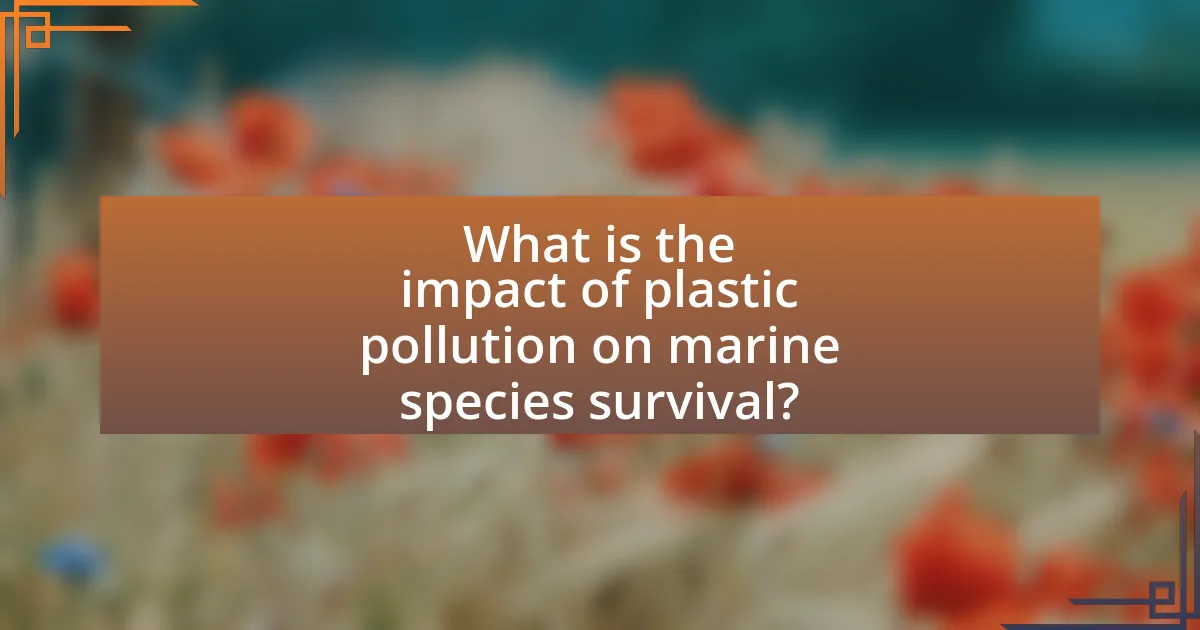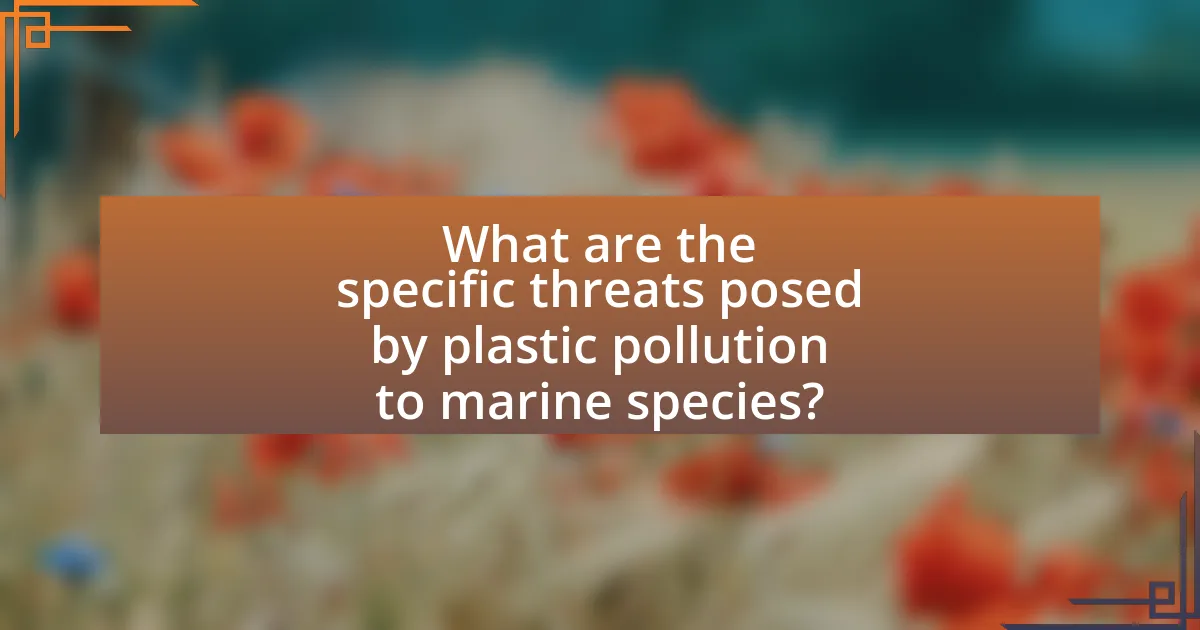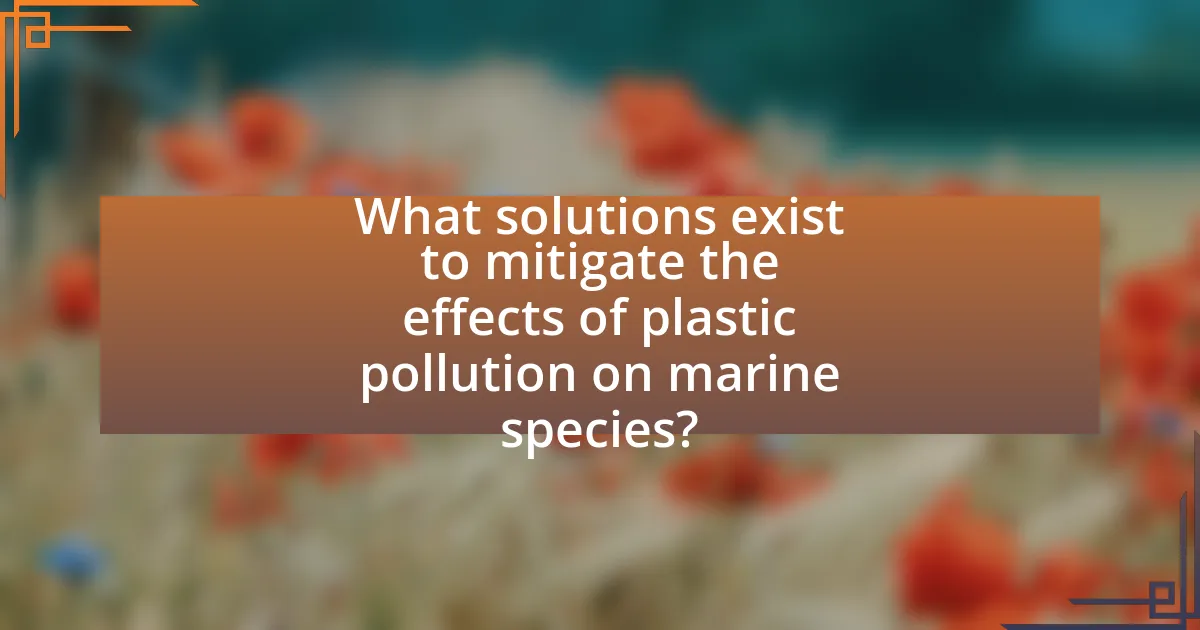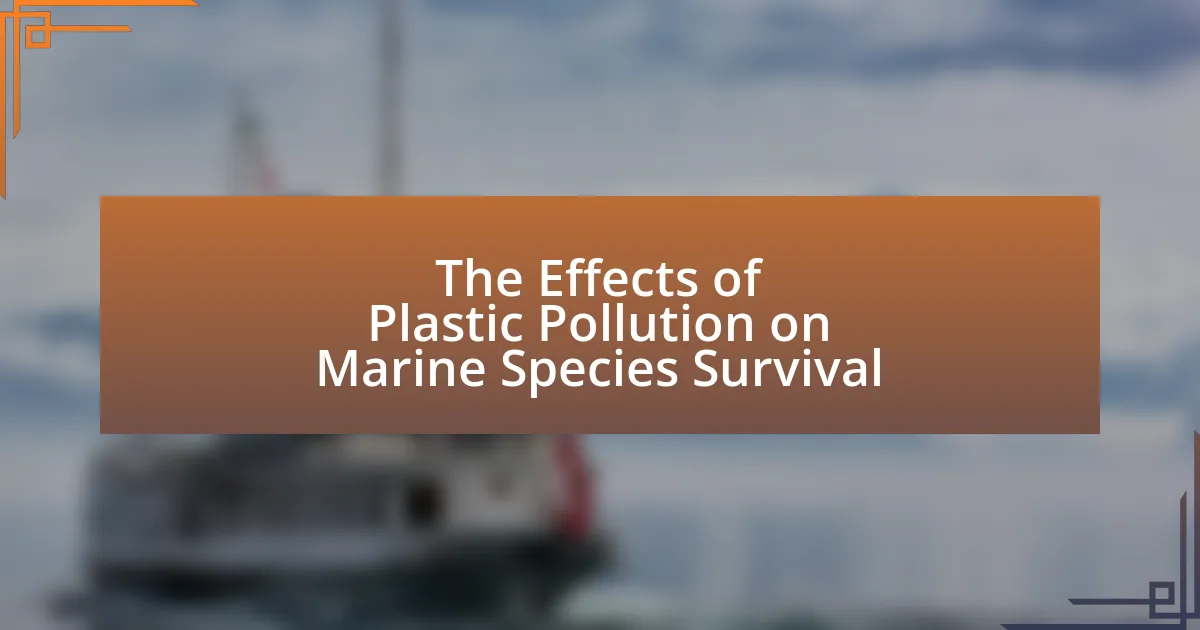The article examines the significant impact of plastic pollution on marine species survival, highlighting the physical harm, toxic exposure, and habitat degradation caused by plastic debris. It details how over 800 species are affected, experiencing issues such as ingestion of microplastics, entanglement, and reduced reproductive success. The discussion extends to the disruption of marine ecosystems and food chains, emphasizing the critical roles marine species play in maintaining ocean health. Additionally, the article explores the long-term effects of plastic pollution, the specific threats posed to various marine species, and potential solutions to mitigate these impacts, including policy changes and community initiatives.

What is the impact of plastic pollution on marine species survival?
Plastic pollution significantly threatens marine species survival by causing physical harm, toxic exposure, and habitat degradation. Marine animals often ingest plastic debris, mistaking it for food, which can lead to malnutrition, intestinal blockage, and death. For instance, studies have shown that over 800 species worldwide are affected by marine debris, with many experiencing reduced reproductive success and increased mortality rates. Additionally, toxic chemicals associated with plastics can leach into the water, impacting the health of marine organisms and disrupting ecosystems. Research published in “Marine Pollution Bulletin” highlights that microplastics can accumulate in the food chain, further endangering species at various trophic levels.
How does plastic pollution affect marine ecosystems?
Plastic pollution severely disrupts marine ecosystems by harming wildlife, degrading habitats, and altering food webs. Marine animals often ingest plastic debris, mistaking it for food, which can lead to malnutrition, internal injuries, and death. For instance, studies have shown that over 800 species are affected by marine debris, with many experiencing entanglement or ingestion of plastics. Additionally, microplastics can accumulate in the food chain, impacting not only marine species but also human health through seafood consumption. The presence of plastic in marine environments also leads to habitat degradation, as it can smother coral reefs and disrupt the growth of seagrass beds, essential for biodiversity.
What types of plastic are most harmful to marine life?
Microplastics and single-use plastics are the types of plastic most harmful to marine life. Microplastics, which are small plastic particles less than five millimeters in size, can be ingested by marine organisms, leading to physical harm and toxicological effects. Single-use plastics, such as bags, straws, and bottles, contribute significantly to marine debris, causing entanglement and ingestion issues for various species. Research indicates that over 800 species are affected by marine debris, with plastics being a major component, as highlighted in the study “Marine Debris as a Global Environmental Problem: Introducing a Solutions-Based Framework” by Eriksen et al. (2014).
How does plastic pollution disrupt food chains in marine environments?
Plastic pollution disrupts food chains in marine environments by introducing harmful materials that are ingested by marine organisms, leading to bioaccumulation and trophic transfer of toxins. When marine animals, such as fish and seabirds, mistake plastic debris for food, they consume it, which can cause physical harm, reduce reproductive success, and lead to death. For instance, a study published in the journal “Science” found that over 800 species are affected by marine debris, with many experiencing reduced survival rates due to ingestion of plastics. Additionally, toxins associated with plastics, such as persistent organic pollutants, can accumulate in the tissues of these organisms and move up the food chain, ultimately impacting larger predators, including humans who consume seafood. This cascading effect alters population dynamics and disrupts the balance of marine ecosystems.
Why is marine species survival critical for ocean health?
Marine species survival is critical for ocean health because these species play essential roles in maintaining ecosystem balance and function. Healthy marine populations contribute to nutrient cycling, habitat structure, and food web dynamics. For instance, keystone species like sea otters help control sea urchin populations, which in turn allows kelp forests to thrive, supporting diverse marine life. Additionally, biodiversity within marine ecosystems enhances resilience against environmental changes, such as climate change and pollution. Studies indicate that ecosystems with higher biodiversity are more productive and stable, underscoring the importance of preserving marine species for overall ocean health.
What roles do marine species play in maintaining ecosystem balance?
Marine species play crucial roles in maintaining ecosystem balance by contributing to nutrient cycling, food web dynamics, and habitat structure. For instance, fish and invertebrates serve as both predators and prey, regulating populations of other species and ensuring biodiversity. Additionally, species like corals and seagrasses provide essential habitats that support various marine life, enhancing ecosystem resilience. Research indicates that healthy marine ecosystems, which rely on diverse species interactions, are better equipped to withstand environmental stressors, including those exacerbated by plastic pollution. Studies show that the decline of key marine species due to plastic ingestion disrupts these interactions, leading to imbalances that can affect entire ecosystems.
How does the decline of marine species affect human populations?
The decline of marine species significantly impacts human populations by disrupting food security and economic stability. As marine species diminish, particularly fish stocks, communities that rely on fishing for sustenance and income face severe challenges. For instance, the Food and Agriculture Organization reported that over 3 billion people depend on fish as a primary source of protein, highlighting the direct link between marine biodiversity and human nutrition. Additionally, the decline of marine species can lead to the collapse of local economies, particularly in coastal regions where fishing and tourism are vital. The World Bank estimates that the global economy could lose up to $83 billion annually due to overfishing and habitat destruction, further emphasizing the economic ramifications of declining marine populations.
What are the long-term effects of plastic pollution on marine biodiversity?
Plastic pollution has significant long-term effects on marine biodiversity, primarily leading to habitat degradation, species extinction, and disruption of food webs. Over time, plastic debris can smother coral reefs, which are vital ecosystems, reducing their ability to support diverse marine life. Research indicates that microplastics, which result from the breakdown of larger plastic items, are ingested by marine organisms, causing physical harm and toxicological effects that can lead to population declines. A study published in the journal “Science” by Wright et al. (2013) found that microplastics are present in the stomachs of various marine species, indicating widespread ingestion and potential bioaccumulation in the food chain. This disruption can alter predator-prey relationships and reduce genetic diversity, ultimately threatening the resilience of marine ecosystems.
How does plastic ingestion impact the health of marine animals?
Plastic ingestion negatively impacts the health of marine animals by causing physical harm, chemical exposure, and nutritional deficiencies. Marine species, such as sea turtles and fish, often mistake plastic for food, leading to blockages in their digestive systems, which can result in starvation or death. Additionally, plastics can leach harmful chemicals, such as bisphenol A and phthalates, into the bodies of these animals, disrupting endocrine functions and leading to reproductive issues. Research indicates that over 800 species are affected by marine debris, with plastic being a significant contributor to mortality rates in marine wildlife.
What are the consequences of habitat degradation caused by plastic waste?
Habitat degradation caused by plastic waste leads to significant ecological consequences, including loss of biodiversity and disruption of marine ecosystems. Plastic debris can smother habitats such as coral reefs and seagrass beds, which are crucial for various marine species. For instance, a study published in the journal “Marine Pollution Bulletin” found that over 800 marine species are affected by marine debris, with many facing increased mortality rates due to entanglement or ingestion of plastics. Additionally, the presence of microplastics in the food chain can lead to toxic effects on marine organisms, further threatening their survival and the overall health of marine ecosystems.

What are the specific threats posed by plastic pollution to marine species?
Plastic pollution poses several specific threats to marine species, including ingestion, entanglement, and habitat degradation. Marine animals often mistake plastic debris for food, leading to ingestion that can cause internal injuries, starvation, and even death. For instance, studies have shown that over 800 species, including sea turtles and seabirds, are affected by plastic ingestion. Additionally, entanglement in plastic waste, such as fishing nets and six-pack rings, can lead to injury or drowning for species like seals and dolphins. Furthermore, plastic pollution contributes to habitat degradation, as microplastics can alter the composition of marine ecosystems, affecting species diversity and abundance. Research indicates that microplastics can disrupt the reproductive systems of marine organisms, further threatening their survival.
How does entanglement in plastic affect marine animals?
Entanglement in plastic severely affects marine animals by causing physical harm, restricting movement, and leading to injury or death. Species such as sea turtles, seals, and birds often become ensnared in discarded fishing gear, plastic bags, and other debris, which can result in drowning, starvation, or infection from wounds. Research indicates that over 100,000 marine mammals and millions of seabirds die each year due to entanglement in plastic waste, highlighting the critical impact of this issue on marine biodiversity and species survival.
Which species are most vulnerable to entanglement?
Marine mammals, such as sea turtles, whales, and dolphins, are the species most vulnerable to entanglement. These animals often become ensnared in discarded fishing gear, such as nets and lines, which can lead to injury, drowning, or death. For instance, the National Oceanic and Atmospheric Administration (NOAA) reports that entanglement is a significant threat to North Atlantic right whales, with fewer than 400 individuals remaining, highlighting the critical impact of human-made debris on their survival.
What are the physical and behavioral consequences of entanglement?
Entanglement in marine species due to plastic pollution leads to severe physical and behavioral consequences. Physically, entangled animals often suffer from injuries such as lacerations, infections, and impaired mobility, which can result in starvation or drowning. For example, sea turtles can become trapped in discarded fishing gear, leading to shell damage and reduced ability to swim effectively. Behaviorally, entanglement can cause stress and altered feeding patterns, as animals struggle to free themselves or avoid entangled areas. Research indicates that entangled marine mammals exhibit increased stress levels, which can affect their reproductive success and overall population health.
What health risks do microplastics pose to marine species?
Microplastics pose significant health risks to marine species, including physical harm, toxicological effects, and disruption of biological processes. Marine organisms can ingest microplastics, leading to internal injuries, reduced feeding efficiency, and impaired growth. Studies have shown that microplastics can carry harmful chemicals and pathogens, which may accumulate in the tissues of marine species, potentially causing endocrine disruption and reproductive issues. For instance, research published in Environmental Science & Technology by Rochman et al. (2013) indicates that microplastics can leach toxic additives, affecting the health of marine organisms. Additionally, microplastics can alter the behavior of species, making them more susceptible to predation and impacting overall marine biodiversity.
How do microplastics enter the food chain?
Microplastics enter the food chain primarily through the ingestion of contaminated water and prey by marine organisms. Small marine animals, such as plankton, consume microplastics mistaking them for food, which then allows these particles to move up the food chain as larger predators eat these contaminated organisms. Research indicates that microplastics have been found in various marine species, including fish and shellfish, highlighting their pervasive presence in marine ecosystems. A study published in Environmental Science & Technology found that over 80% of marine species examined contained microplastics, demonstrating the extent of this issue and its implications for marine species survival.
What are the potential effects of microplastics on reproductive health?
Microplastics can adversely affect reproductive health by disrupting endocrine functions and causing developmental issues in marine organisms. Studies have shown that exposure to microplastics can lead to altered hormone levels, which may result in reproductive impairments such as reduced fertility and abnormal development of embryos. For instance, research published in Environmental Pollution by Rist et al. (2017) indicates that microplastics can leach harmful chemicals that mimic hormones, potentially leading to reproductive toxicity in aquatic species. Additionally, a study in Marine Pollution Bulletin by Besseling et al. (2017) found that microplastics can accumulate in reproductive tissues, further exacerbating these negative effects.
How does plastic pollution contribute to the spread of invasive species?
Plastic pollution contributes to the spread of invasive species by providing a floating habitat that allows these species to travel across oceans and colonize new environments. Research indicates that plastic debris, such as bottles and bags, can carry organisms like barnacles and algae, enabling them to survive long distances. A study published in the journal “Marine Biology” found that over 200 species of marine organisms were identified on plastic debris, demonstrating how this pollution facilitates the introduction of non-native species into ecosystems where they can disrupt local biodiversity and compete with native species for resources.
What mechanisms allow invasive species to thrive in polluted waters?
Invasive species thrive in polluted waters primarily due to their ability to exploit altered habitats and reduced competition. Polluted environments often favor species that are more tolerant to contaminants, allowing invasive species to establish themselves where native species may struggle. For instance, studies have shown that certain invasive species can utilize pollutants as resources or can outcompete native species that are stressed by pollution, leading to a decline in biodiversity. Additionally, the presence of plastic pollution can provide new substrates for invasive species to colonize, further enhancing their survival and proliferation in these compromised ecosystems.
How does this affect native marine species and ecosystems?
Plastic pollution adversely affects native marine species and ecosystems by causing physical harm, disrupting food chains, and leading to habitat degradation. Marine animals often ingest plastic debris, mistaking it for food, which can result in malnutrition, intestinal blockage, and death. For instance, studies have shown that over 800 species are affected by marine debris, with many experiencing reduced reproductive success due to the ingestion of microplastics. Additionally, plastic pollution alters habitats, such as coral reefs, by smothering them and reducing their ability to recover from stressors. This disruption can lead to a decline in biodiversity, as species that rely on healthy ecosystems for survival are negatively impacted.

What solutions exist to mitigate the effects of plastic pollution on marine species?
Solutions to mitigate the effects of plastic pollution on marine species include reducing plastic production, enhancing waste management systems, and promoting biodegradable alternatives. Reducing plastic production can be achieved through policies that limit single-use plastics and encourage recycling, which has been shown to decrease marine debris by up to 30% in regions with strict regulations. Enhancing waste management systems involves improving collection and recycling rates, as evidenced by studies indicating that better waste management can reduce ocean plastic by 50% in coastal areas. Promoting biodegradable alternatives, such as plant-based plastics, can also lessen the impact on marine life, as these materials break down more quickly in marine environments, reducing ingestion and entanglement risks for marine species.
How can policy changes reduce plastic pollution in oceans?
Policy changes can significantly reduce plastic pollution in oceans by implementing stricter regulations on plastic production and waste management. For instance, bans on single-use plastics, such as bags and straws, have been adopted in various regions, leading to a measurable decrease in plastic waste entering marine environments. According to a study published in the journal “Science,” countries that enacted such bans saw a reduction in plastic pollution by up to 30% within a few years. Additionally, policies promoting recycling and the development of biodegradable alternatives can further mitigate the impact of plastic on marine ecosystems, as evidenced by initiatives in countries like Sweden, which has achieved a recycling rate of over 99% for plastic bottles. These policy measures create a framework that encourages sustainable practices and reduces the overall volume of plastic waste that threatens marine species survival.
What regulations have been effective in other regions?
Regulations that have been effective in other regions include the European Union’s Single-Use Plastics Directive, which aims to reduce plastic waste by banning specific single-use plastic items and implementing measures for alternatives. This directive has led to a significant decrease in plastic consumption in member states, with reports indicating a reduction of up to 50% in the use of certain plastic products within two years of implementation. Additionally, countries like Canada have enacted similar bans on single-use plastics, resulting in increased public awareness and participation in recycling programs, which further mitigates plastic pollution’s impact on marine species.
How can international cooperation enhance marine conservation efforts?
International cooperation can enhance marine conservation efforts by facilitating the sharing of resources, knowledge, and best practices among countries. Collaborative initiatives, such as the Global Programme of Action for the Protection of the Marine Environment from Land-based Activities, demonstrate how countries can work together to address issues like plastic pollution, which significantly impacts marine species survival. For instance, a study published in the journal “Science” indicates that coordinated international policies can reduce plastic waste entering oceans by up to 50% over a decade, thereby improving the health of marine ecosystems and protecting vulnerable species.
What role do individuals and communities play in combating plastic pollution?
Individuals and communities play a crucial role in combating plastic pollution by actively participating in waste reduction, recycling initiatives, and advocacy for policy changes. For instance, community-led clean-up events have been shown to significantly reduce plastic waste in local environments, as evidenced by the Ocean Conservancy’s International Coastal Cleanup, which removed over 20 million pounds of trash from coastlines in 2019. Furthermore, individuals can influence change by adopting sustainable practices, such as using reusable bags and containers, which collectively can lead to a substantial decrease in plastic consumption. Research indicates that community engagement in environmental education programs increases awareness and promotes behaviors that reduce plastic pollution, thereby protecting marine species and their habitats.
What are effective practices for reducing plastic use in daily life?
Effective practices for reducing plastic use in daily life include using reusable bags, bottles, and containers. By opting for these alternatives, individuals can significantly decrease their reliance on single-use plastics, which contribute to marine pollution. For instance, a study by the Ellen MacArthur Foundation found that if current trends continue, there could be more plastic than fish in the ocean by 2050. Additionally, choosing products with minimal or no plastic packaging can further mitigate plastic waste. Engaging in community clean-up efforts and advocating for policies that limit plastic production also play crucial roles in addressing plastic pollution.
How can community initiatives raise awareness about plastic pollution?
Community initiatives can raise awareness about plastic pollution by organizing educational campaigns and local clean-up events. These initiatives engage community members directly, fostering a sense of responsibility and urgency regarding plastic waste. For instance, studies show that community-led clean-up events not only remove plastic from local environments but also educate participants about the detrimental effects of plastic pollution on marine species, such as entanglement and ingestion, which can lead to decreased survival rates. Furthermore, initiatives that collaborate with schools and local organizations can amplify their reach, ensuring that information about the impact of plastic pollution is disseminated widely and effectively.
What innovative technologies are being developed to address plastic pollution?
Innovative technologies being developed to address plastic pollution include advanced recycling methods, biodegradable plastics, and bioremediation techniques. Advanced recycling methods, such as chemical recycling, allow for the breakdown of plastics into their original monomers, enabling the creation of new plastic products without degrading quality. Biodegradable plastics, made from renewable resources, are designed to decompose more quickly than traditional plastics, reducing their environmental impact. Bioremediation techniques utilize microorganisms to break down plastic waste in marine environments, effectively reducing pollution levels. These technologies are crucial as plastic pollution poses significant threats to marine species, with studies indicating that over 800 species are affected by marine debris, highlighting the urgent need for effective solutions.
How do these technologies help in cleaning up marine environments?
Technologies such as advanced filtration systems, autonomous drones, and bioremediation techniques significantly aid in cleaning up marine environments by effectively removing plastic waste and pollutants. Advanced filtration systems can capture microplastics and other contaminants from water, thereby reducing their harmful impact on marine life. Autonomous drones equipped with sensors and collection tools can identify and gather debris from hard-to-reach areas, enhancing cleanup efficiency. Bioremediation techniques utilize microorganisms to break down pollutants, promoting natural recovery processes in affected ecosystems. These technologies collectively contribute to healthier marine habitats, which is crucial for the survival of various marine species affected by plastic pollution.
What are the future prospects for biodegradable alternatives to plastics?
The future prospects for biodegradable alternatives to plastics are promising, driven by increasing environmental awareness and technological advancements. Research indicates that biodegradable materials, such as polylactic acid (PLA) and polyhydroxyalkanoates (PHA), can significantly reduce plastic pollution, particularly in marine environments. For instance, a study published in the journal “Nature” highlights that these materials can decompose in marine conditions, mitigating the harmful effects of traditional plastics on marine species. Furthermore, the global market for biodegradable plastics is projected to grow at a compound annual growth rate (CAGR) of over 20% from 2021 to 2028, reflecting a strong shift towards sustainable materials. This trend is supported by regulatory measures aimed at reducing plastic waste, further enhancing the viability of biodegradable alternatives.
What practical steps can individuals take to support marine species survival?
Individuals can support marine species survival by reducing plastic use and participating in clean-up efforts. By minimizing single-use plastics, such as bags and straws, individuals can decrease the amount of plastic waste that enters oceans, which is a significant threat to marine life. According to the United Nations, approximately 800 species worldwide are affected by marine debris, particularly plastics. Additionally, participating in local beach clean-ups helps remove existing plastic pollution, directly benefiting marine ecosystems. Engaging in advocacy for policies that limit plastic production and promote recycling also contributes to long-term solutions for marine species survival.
